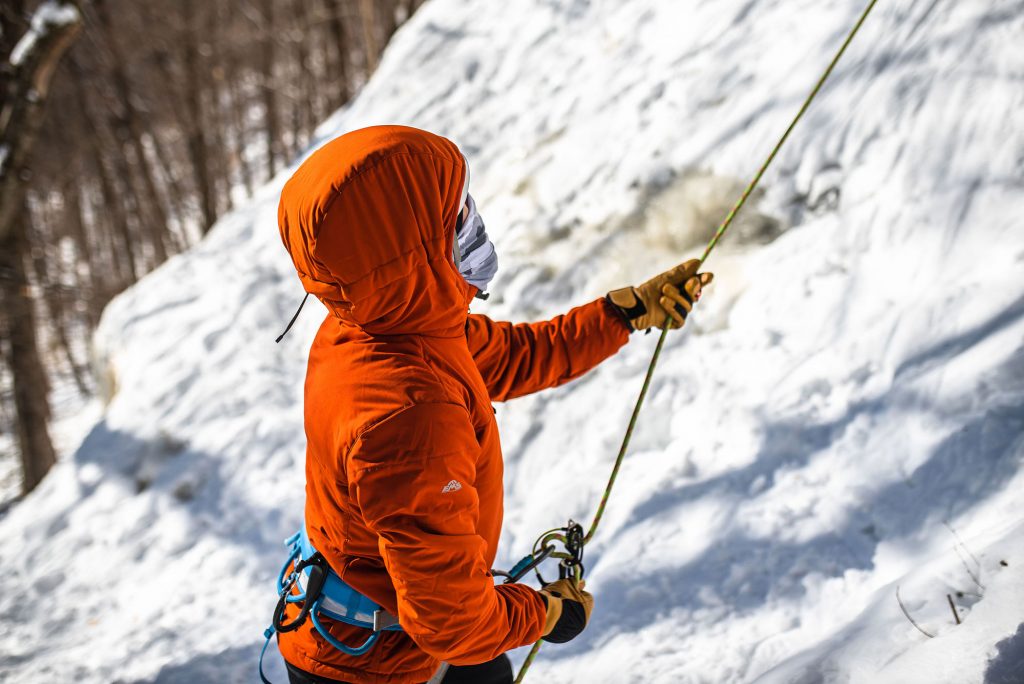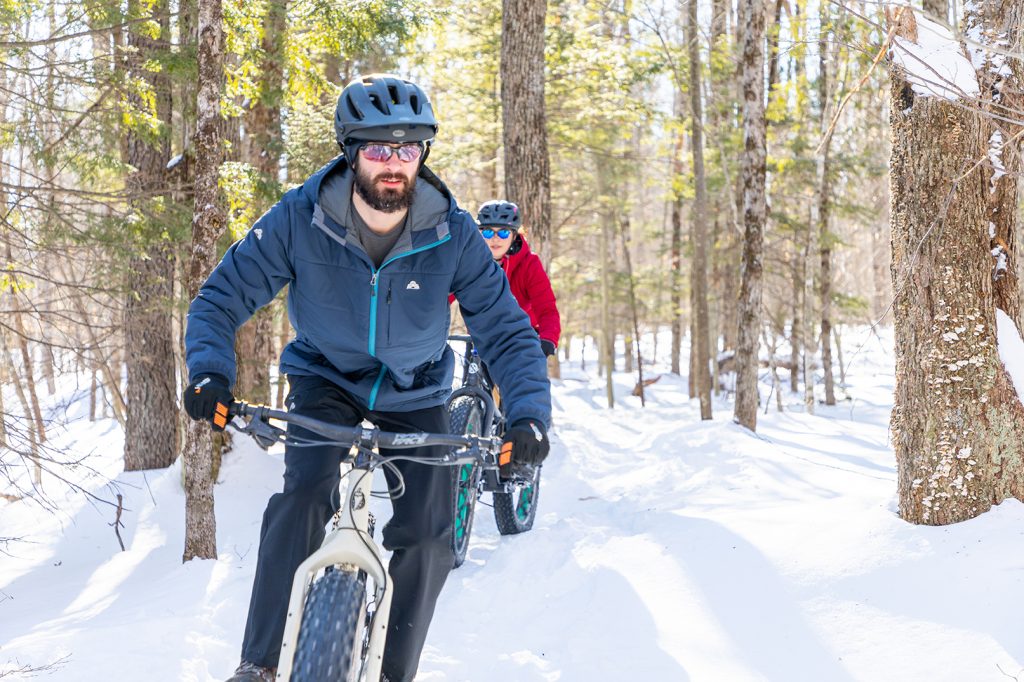Active insulation is quickly becoming a mainstay for those pursuing aerobic activities in cold weather and is showing up in the kits of everyone from backcountry skiers to hikers to fat bikers. What attracts many users to active insulation is its ability to provide warmth to not only those pushing the pace on the skin track or trail but also those engaged in lower-energy activities, like sitting on a mountain summit or traveling to the rock gym.

What Is Active Insulation?
Active insulation is a catchall term used for a variety of synthetic insulations that are designed to provide warmth and breathability to those moving through cold environments.
A Little Bit of History
Although it’s well-suited for recreation and tackling winter classics like steep lines in Tuckerman Ravine and alpine ice climbs such as Shoestring Gully, the first active insulation was originally developed by Polartec for the U.S. Special Forces. The insulation was called Polartec Alpha and developed with the requirements of soldiers operating in cold climates in mind. The goal: to be rugged, packable, wicking, quick-drying, consistently warm, and effective for stop-and-go activities. After all, the battlefield is not a place to tinker with layers, not to mention that body armor and packs make layers time-consuming to remove.
But the qualities prized by soldiers were also desired by everyone from outdoor professionals to weekend warriors. Although the battlefield isn’t a time to mess around with layers, neither is the outdoors. You also don’t want to stop to swap layers when chasing powder runs at a BCA glade or when trying to stay ahead of sunset on Mount Washington’s Lionhead.
Why Choose Active Insulation?
What makes active insulation an appealing addition to cold-weather kits is that it blends some of the best qualities of multiple tried-and-true outdoor pieces—namely fleece and down/synthetic static insulated outerwear—into one versatile layer.
Before active insulation, fleece was the go-to fabric for staying warm and dry while on the move. While fleece offers an excellent range of motion, plenty of warmth, and wicks well, it’s also bulky, doesn’t pack particularly well (just ask anyone who has ever tried to stuff a 300-weight fleece into a pack), and only insulates so-so when standing still. Active insulation offers a high-performance alternative that breathes and moves moisture similar to your favorite fleece but packs down much smaller and keeps you comfortable when stopped.
On the other end of the spectrum, down– and synthetic-filled pieces have long been trusted to provide maximum warmth in lower-output situations. Traditional insulation excels at providing and retaining heat but struggles to move moisture and breathe. If you’ve ever broken a good sweat while heading uphill in a down coat, despite arctic temperatures, you know what we mean. Unlike static insulation, active insulation is able to vent heat and move moisture to keep you warm and dry on the uphill but also trap heat and keep you cozy on the way down.
Ultimately, active insulation adds significant versatility to the layering systems of those participating in cold-weather activities and reduces the need to frequently add and remove layers. And it works well as both a stand-alone layer in cold weather while working hard but also as a mid-layer paired with everything from another puffy for additional warmth to a shell for superior water and wind resistance.

How Active Insulation Works
The science behind how active insulation works varies significantly, depending on everything from the manufacturer to the desired level of insulation. Products like Polartec Alpha are constructed by connecting lofted hydrophobic (water-repellant) polyester fibers to a continuous mesh core. This creates an abundance of dead air space in the insulation which traps air warmed by your body and works the same way down and synthetic coats do to keep you toasty. However, unlike traditional down and synthetic layers, active insulation is extremely porous, which allows excess heat and, more importantly, moisture to move from the inside of the garment to the outside.
Unlike down and synthetics, which require baffles to keep the insulation in place, active insulation is constructed in one connected sheet. This provides it with a host of advantages when it comes to moving heat. For instance, the lack of baffles allows heat to flow freely through the jacket—moving it from warm areas like under the arms to colder areas like the chest.
The continuous, connected-sheet construction of active insulation also allows it to be employed in a variety of ways—such as sandwiched between an outer shell and inner lining, paired with just a face fabric, or as a standalone piece. This lets manufacturers tailor active insulation pieces to take advantage of the insulation’s unique qualities. For example, standalone pieces excel as mid-layers and allow maximum airflow while active insulation paired with a shell-like surface and backing is better suited for retaining warmth.
Primaloft has recently released a new insulation inspired by the animal kingdom which works similarly to the winter coat of mammals. After all, your furry winter hiking partner doesn’t have the option to swap out their fur coat when they get too warm. Primaloft Active Evolve combines different lengths of coarser, high-denier fibers to trap warm air with softer, finer denier fibers for added warmth and a cozy feel. The different lengths and deniers allow the material to trap warm air, but not impede breathability. Like other active insulation, Primaloft Active Evolve can be paired with a shell and lining, only a lining, or as a standalone.
The Place for Traditional Insulation
While active insulation is changing the way we layer, there’s still a place for traditional insulation pieces, like down and synthetic jackets. In fact, traditional insulation pieces are excellent complements to active insulation. This is because the air permeability that allows active insulation to vent warm air from your body also allows for the penetration of cold exterior air. This is not an issue when on the move and generating a lot of heat, but can cool you off quickly when stopped. And it is a great reason to have a traditionally insulated jacket ready for summit stops and rest breaks, especially in extremely windy and cold conditions.
The advent of active insulation has provided one more tool for keeping comfortable in cold weather and added versatility to layering systems for a wide range of activities—from climbing to hiking to cycling.
Tim Peck and Doug Martland
Tim and Doug met long ago at the Eastern Mountain Sports in Canton, Massachusetts. Bonding over a love of slick Quincy Quarry granite, White Mountain sufferfests, and scheming up adventures while folding tee-shirts, today Tim and Doug collaborate to write about their favorite outdoor activities and occasionally get nostalgic about tee-shirt tables.




